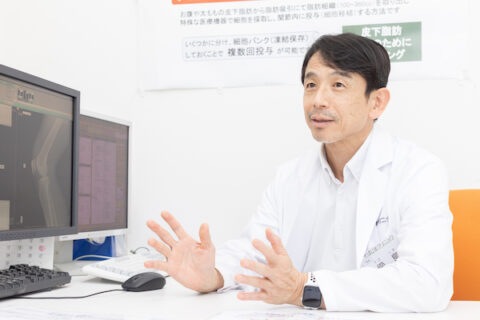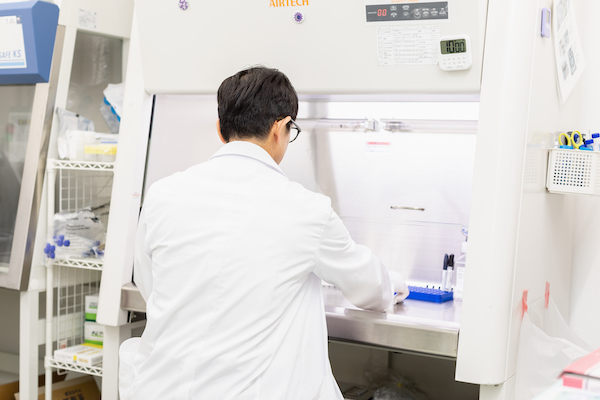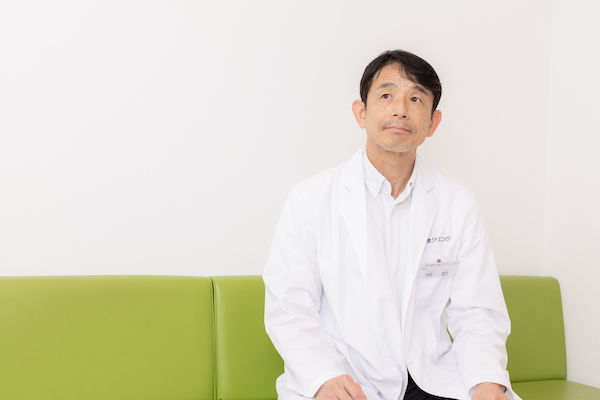- HOME>
- Doctor Interviews
Encountering Regenerative Medicine: Discovering its Potential
Asking Dr. Sobajima: An Insightful Interview
The goal of regenerative medicine is to improve the quality of life, as well as diseases and injuries that cannot be cured by modern Western medicine.
INTERVIEW 01
How did you encounter regenerative medicine?
I first encountered regenerative medicine in 2002 when I was studying abroad at the University of Pittsburgh in the United States. Initially, I worked on gene therapy for intervertebral discs as an intervertebral disc specialist. However, while studying abroad, I encountered the new field of stem cell therapy and learned about the potential of regenerative medicine.
INTERVIEW 02
What is the appeal and goal of regenerative medicine?
As the human body ages, intervertebral discs and cartilage degenerate, and once they are damaged, they cannot return to their original state. In response to this reality, regenerative medicine aims, broadly speaking, to “restore damaged tissue”. However, this is extremely difficult, and in reality, it is important to “delay the degeneration of the painful tissue”. Gene therapy and stem cell therapy are considered effective ways to slow down the rate of degeneration.
The phenomenon of human degeneration, or “aging,” is inevitable. But it is possible to delay it and make it last longer. Regenerative medicine is an important means to slow down the progression of aging phenomena.
INTERVIEW 03
What about your activities after returning to Japan?
 After returning from studying abroad, I focused my efforts on the “clinical application” of regenerative medicine as a part-time assistant professor at Osaka Medical College (OMC). Convinced that regenerative medicine would become the future of treatment, I continued basic research at OMC with the aim of “bringing it to a stage where it can be used by humans”.
After returning from studying abroad, I focused my efforts on the “clinical application” of regenerative medicine as a part-time assistant professor at Osaka Medical College (OMC). Convinced that regenerative medicine would become the future of treatment, I continued basic research at OMC with the aim of “bringing it to a stage where it can be used by humans”.
Clinic opened in 2011
Aiming for clinical application of regenerative medicin
INTERVIEW 04
What were your thoughts on opening a clinic?
I opened this clinic because I wanted to advance the clinical application of regenerative medicine. We opened our business in 2011, but then in 2014 the Act on the Safety of Regenerative Medicine, etc. was enacted, which had a major impact on our activities. With the enforcement of this new law, it is now possible to apply regenerative medicine in clinics.
INTERVIEW 05
Has a research group been established?
The establishment of the “Adipose-Derived Stem Cells Research Group” (https://society.medipreneur-jp.com/) is one of the major topics related to regenerative medicine at our hospital. I also serve as a representative caretaker. Except for the coronavirus pandemic, it has been held every year since it was first held in 2015, and 2023 will already be the 8th time.
The study group gathers volunteer doctors, researchers, and companies from all over Japan. Many of the participants are doctors from university hospitals, municipal hospitals, clinics, etc., as well as many from companies, with more than 100 people participating each year.
I feel very honored to be able to work with these people.
INTERVIEW 06
Why are our activities evaluated?
For the past 20 years, I have been researching stem cells and making efforts to apply them clinically. Also, perhaps it is because I have been building up evidence for this treatment together with other researchers and doctors who are also aiming for clinical application.
Because I had already conducted a lot of applied research, I was able to liven up the study group with other researchers who were also aiming for clinical applications.
Joint research with experts
Focus on disseminating information
INTERVIEW 07
What kind of initiatives will you take in joint research?
Regenerative medicine can be applied not only to the treatment of orthopedic diseases such as osteoarthritis that we provide, but also to various fields. Research at different stages of progress is being carried out in various regions, and through collaboration with these researchers, we are accumulating the results of basic research that effectively utilizes the obtained cells.
We have been contacted by researchers from all over the country, especially university professors, saying they would like to conduct research together and aim for clinical application, and we are conducting joint research in cooperation with these experts.
INTERVIEW 08
What is your relationship with Professor Ryosuke Kuroda, Department of Orthopedics, Kobe University School of Medicine?
The relationship with Prof. Kuroda is also an important topic that cannot be ignored when discussing regenerative medicine at our hospital. Prof. Kuroda and I are study abroad friends in Pittsburgh. Although we chose different paths, Dr. Kuroda became a professor and I opened a clinic, we shared the same aspirations for clinical research.
Together with Prof. Kuroda, we launched a regenerative medicine project at our hospital, and Kobe University will participate in the joint research. As a result, our hospital is now not only assisted in medical treatment by doctors from Kobe University, but also jointly conducting research. We also write papers together and disseminate treatment evidence not only in Japan but all over the world.
INTERVIEW 09
Are you putting effort into disseminating information?
The treatments we provide are based on scientific evidence. In order to propose a new treatment method, it is most important to build up evidence to support it. Without evidence, other doctors won’t be willing to try a new method. So now we’re building evidence for the future.
INTERVIEW 10
Isn't it difficult to try new methods?
That may be true, but trying new treatment methods and documenting the results is an essential element for medical progress. University professors are primarily engaged in such research activities, but in reality, there are various constraints on clinical research on regenerative medicine within universities, making it difficult to proceed.
We are collaborating with university professors who are in difficult situations to build evidence together. We are moving forward by supporting each other. I personally have been involved in these activities with a sense of mission, and now, nearly 20 years after returning from studying abroad, I feel that they are slowly taking shape.


Regenerative medicine is built on standard treatment
Combination with existing treatments is important
INTERVIEW 11
What do you consider important in regenerative medicine?
Regenerative medicine is attracting attention as a new treatment method and is often thought of as a “special treatment”, but what we emphasize in our medical examinations and academic conference activities is that “existing treatment methods are also important”. We are telling people that “we should not rely on regenerative medicine alone” and “it is important to combine existing treatment methods.” We believe that by advancing this understanding, we will deepen our understanding of the position of regenerative medicine and its effectiveness.
INTERVIEW 12
What is important in your daily medical treatment?
The most important thing is to “examine the patient thoroughly.” This is the basic and most important point. We thoroughly understand the details of the treatments a patient has received so far, and before considering regenerative medicine, we make sure that the patient is receiving standard treatment properly. This is because regenerative medicine is an addition to standard treatment.
INTERVIEW 13
Lastly, what would you like to convey to those who view your website?
When introducing a new treatment method, it is important to consider how it can be integrated with existing treatments. It is important to take a thorough look at existing treatments and then incorporate new treatments. I would like to understand the characteristics of regenerative medicine and utilize it effectively. This is true for any disease; by applying an appropriate treatment method for that disease and applying new treatments based on that, the effectiveness of treatment can be maximized. This is our hospital’s basic approach to regenerative medicine, and we proceed while discussing treatment policies with experts to ensure that the treatment does not go in the wrong direction. In order to further develop regenerative medicine, we will continue to form alliances with experts in various fields and steadily accumulate evidence while having discussions together. This is my wish, and I believe that it will become a “bridge” for the development of regenerative medicine in the future.




